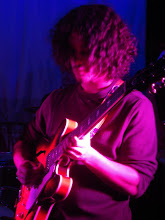Today it's all about recycling, maximizing efficiency, reducing emissions. Actually I'm not sure what that last one has to do with making music, but the first two are certainly relevant. In Mick Goodrick's Almanac of Guitar Voice-Leading Volume III, there is a catalogue of all the different applications a collection of 4 notes (otherwise known as a chord) could have.
The notes of the Cmaj7 chord, for instance, could be construed as extensions over a Dm7, or a D7sus4, an F maj7, make a nice passing chord on an F#m7(b5). There are many different ways that you could use those 4 notes, and all the voicings that consist of them, in a wide variety of situations. So, instead of trying to learn a million new voicings, we might want to spend some thinking about how to get more milage out of the old ones also. As I was lucky enough to hear Mick point out in person, this becomes even more evident when dealing with less common inversions for guitar such as drop 2 and 4, where sometimes an Fmaj7 might sound more like a Cmaj7add4, for instance. In other words, depending on the order and spacing of the notes, the chord might not even sound like itself, especially without a bass instrument playing the root.
Ok, so we all know about chord substitutes, what’s the big deal? Well there’s a huge deal! This catalogue in Mick’s book is almost 40 pages long! That means that, any given chord you can think of probably has anywhere from six to twelve applications you’ve never even considered and certainly don’t ever use, especially when you’re improvising.
Now I personally run into a voicing a month that I keep if I’m lucky. It takes time to digest anything and integrate any concept, as I’ve been discussing in regards to triads, but for some reason chords take much longer for me. Especially as the sounds start getting weirder, you almost have to build your sound from scratch around the chords because there’s no way they’ll fit in the context of what you were doing before. Just yesterday or the day before I started looking at the different drop 2and4 inversions, but I’m a long way off from using them in what seems to be (perhaps falsely) a spontaneous manner. And that’s only in the context of putting them where they’re most obviously supposed to go: where they match the chord on the paper. Now I’m supposed to take every single voicing I know and do that a dozen times over!? We all substitute Dm7 for Bbmaj7, and perhaps we get so used to subbing Fmaj7 for Dm7 that we end up making the connection between Bbmaj7 and Fmaj7 in a roundabout way that’s quite unconscious and totally natural. But that’s just a network of 3 chords!!!! We’re talking about 10 or 12!! and even then I bet you only use half of your Fmaj7 voicings at the most over Bbmaj7 because it was never conscious to begin with and you’re missing out on plenty of inversions which would sound absolutely amazing.
Ok, so in other words, this is a nice idea, but if we want to harness the power of this concept and apply it to our practice and eventually playing, it should become clear that no human being could ever possibly internalize in a useful way more than a small fraction of this material. It’s just a way to think ourselves into unconventional sounds, to find a small corner of the harmonic universe that excites us and then to live there for a while.
So, now that you get the concept and also how stupidly huge the possibilities are, and maybe some of my excited nervousness has been contagious, it’s time to get to my real point (I know, I wish it didn’t take me so long also).
Well they all fit in the whole tone or diminished scale, which means that the resulting fingering can all be applied in either 4 or 6 places on the guitar neck that will fit over an altered dominant (different notes, same guitar fingering).

So this is a great way to save time when trying to understand these kinds of concepts, because you can get at least 4 wildly different sounds that fit on a dominant chord, that all are the same fingering as the voicing you already know. I find this makes things a bit more complicated at first, but then you wind up with a huge amount of dominant voicings, ranging from totally clichéd to totally wacky and there’s only 6 or seven fingerings and then there’s only 2 or 3 sets of fingerings for all the keys instead of 12 because these are derived from symmetrical scales.
Once you really start getting into this kind of thought process every key becomes unique. Aside from the fact that there’s a lot of information to process and it takes a long time to be able to transpose that information freely, the even bigger problem on guitar (or piano or anything else) is that some of these ideas are going to be unbelievably easy to execute and some unbelievably difficult, and this might change depending on the key. You might start practicing in C and hate a certain voicing and think you’ll never use it, move on to something else, forget about it, and a couple of months later it just pops up in F# and it’s totally playable and you love it.
If you tried inverting most of the chords above after you’d slid them up or down a major second or minor 3rd, you might have been disappointed to discover that this results in even more fingerings, not less (although excited to discover that those fingerings are also transposable).



No comments:
Post a Comment